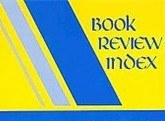Book Review Index

What Harner has to say about BRI: This index is of book and serial reviews in ~400 newspapers, periodicals, and scholarly journals. They are organized by year, each year in three volumes, with an annual cumulation. The index does include many poor reviews and unscholarly publications, but is still the BEST source for finding reviews of creative works and how they are received.
The basic set-up for a BRI remains constant since its inception in 1965 (reviewed works before 1965 must be looked for in Book Review Digest, located directly to the right of BRI in the Dupre Library). Every cumulation begins with an introduction, stressing that comments and suggestions are welcome, and provides information to Gale Group, BRI’s current publisher. There is also a helpful Users Guide, which gives a clear description of how entries are organized. Here is the organization of most entries:
Author/Editor Last Name, First Name – Name of the Work Reviewed
Abbr. of Reviewing Title – Volume or date/issue – page of review – [length of review]
Some things to note about the format:
- If multiple authors/editors exist with the same name, birth years and middle names are given to distinguish between them.
- Sometimes a letter will appear before the name of the reviewing title. ‘C’ denotes book for children; ‘y’ denotes a book for young adults, and ‘p’ indicates a review of a periodical or newspaper.
- The length of review is categorized one of three ways: 1-50, 51-500, and 500+.
Following the Users Guide is the Publications Indexed section, organized alphabetically by abbreviation (therefore the listing for Ambio (Ambio) comes after the one for American Antiquity (Am Ant)). Information about the publication is also given, including frequency, ISSN, subscription address, and URL, if available.
Next is the bulk of BRI: the works being reviewed. They are listed in alphabetical order by author/editor’s last name, in the above given format. There is also a Title Index section following the review listings. If a specific work is being looked for, the Title Index should be checked first to ensure the work is listed in the reviewed section. This is because many reviews come out in years following the actual publication of a work, and as BRI does provide reviews of electronic versions of a work (such as a book on tape), it is useful to check the Title Index for a work in subsequent years following publication.
Didn’t you say something about a different book for pre-1965 book reviews?
Thanks for reminding me! Book reviews prior to 1965 can be found in Book Review Digest, Ref Z1219.C96. Again, listings are organized by yearly cumulations (March-February), and then alphabetically by author/editor. BRD also has a title AND subject index, making it particularly useful for general searches. BRD also provides full citations of the works being reviewed, a brief summary of the work, and brief summaries of the reviews, providing clues to how critical the review truly is. However, BRD provides a fraction of the periodicals that BRI has, and as Harner notes, is weak in its scope of the humanities and is incredibly restrictive in its selection process.
Why is this an important reference?
The reception of a novel is important in many arguments one could make about a work. For example, if one was to write a paper about William Styron’s “The Confessions of Nat Turner,” it would be important to note the large amounts of both criticism and praise heaped onto the novel.
Where is this index found?
The catalogue listing is REF Z1035.A1. Nearly all editions have a bright yellow and blue cover, making it very noticeable among the drab browns and reds of most other reference books. As a reference book, it cannot be checked out.
Are there any issues I should be aware of?
Harner notes that BRI is the best source for finding reviews, however, this may be merely because it is the most extensive index available. While it does include reviews in some scholarly journals, it certainly does not include reviews for ALL scholarly journals. The inclusions of such mundane “periodicals,” such as People Weekly, detract for the overall credibility of the index. BRI must be supplemented by additional sources, such as catalogues and databases. It should be the first place to look for reviews of works, but research should not end there. Databases such as JSTOR and ProjectMuse offer searches specifically for reviews, and that avenue is recommended after BRI and BRD have been utilized.
Isn’t there an online source I can use?
There is an online version of the BRI, and some of the reviews listed in the text BRI are only available online. The link Harner gives is now dead, but BRI online does exist at: http://www.gale.cengage.com/BRIOnline/index.htm. Sadly, UL does not have a subscription to the actual online catalogue or the 5.6 million reviews it offers. But seriously, you’re in grad school now. You should be in the library all the time anyway.